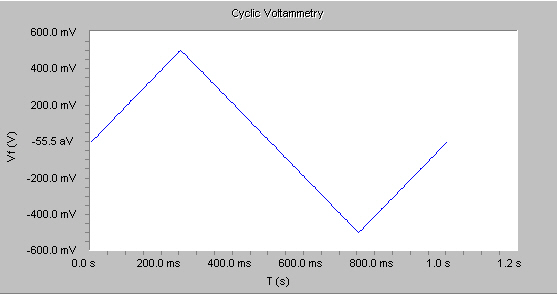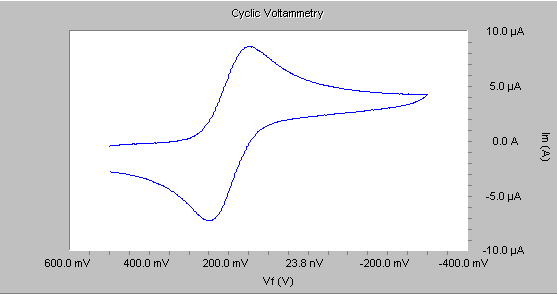Cyclic Voltammetry Purpose
Cyclic Voltammetry is used to study the mechanism, kinetics, and thermodynamics of chemical reactions. Both heterogeneous reactions occurring at the electrode surface, and homogeneous reactions in solution can be studied.
In the classical Cyclic Voltammetry triangle waveform, the potential is swept from an Initial E, to Vertex E, and back to Final E, where Final E equals Initial E. An example of this applied waveform is shown below. Repeating this waveform for N times performs N cycles of Cyclic Voltammetry.

In the Physical Electrochemistry system, we use the more generic double-vertex triangular waveform shown below. This applied waveform allows you to set a second vertex potential (Scan Limit 2 in the software). Setting ScanLimit2 and Final E to equal the Initial E can perform the classically defined triangle waveform for cyclic voltammetry.

Let’s examine a simple example of a Cyclic Voltammetry experiment, using the classically defined triangular waveform. For the case of a simple one-electron transfer reaction, the resulting current vs. voltage plot gives the familiar “duck shape” waveform shown below. In these cases, the reversible potential for the electron transfer can be evaluated from the half-wave potential for the redox process.
You can study electron-transfer kinetics by varying the scan rate of the applied potential and observing the increase in ΔEp (Nicholson). An overall review of potential sweep voltammetry methods is covered in Chapter 6 of Bard and Faulkner.

In cases where the chemistry of the system is more complicated, cyclic voltammetry can be used to determine the mechanisms and kinetics involved. In their work in the 1960s, Nicholson and Shain published a series of articles that discussed the use of cyclic voltammetry to study chemical systems which included chemical reactions either proceeding or following the electron transfer seen in the cyclic voltammogram. We encourage you to review these works for a better understanding of the versatility of the cyclic voltammetry experiment.

Comments are closed.